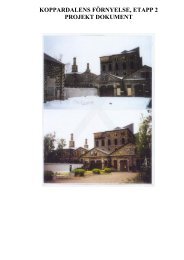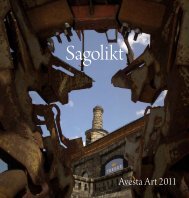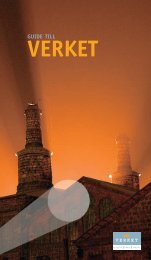Avesta Art 2010 - Verket
Avesta Art 2010 - Verket
Avesta Art 2010 - Verket
- TAGS
- avesta
- verket
- www.verket.se
Create successful ePaper yourself
Turn your PDF publications into a flip-book with our unique Google optimized e-Paper software.
Anber Onar<br />
- Genom det här projektet vill jag se igenom den synbara ytan, ställa<br />
frågor och starta debatt Eftersom samma händelse kan ses med<br />
olika ögon beroende på tid och vidsynthet i kultur och historia, är det<br />
viktigt att öppna för alternativa möjligheter till tolkning Jag är också<br />
intresserad av människors gensvar och hur de förändrar sina perspektiv<br />
när de möter mina installationer Konsten är en väg att uppfatta och<br />
omvandla världen, både för konstnären och för besökaren som deltar<br />
Anber Onar är född på Cypern och utbildad i konst vid universitet i<br />
bl a Florida, New Jersey och New York Utställningslistan är lång och<br />
omfattar inte minst konst i form av performances i både Europa och<br />
USA Hon har även undervisat i konst, konsthistoria, kommunikation och<br />
mediestudier samt grafisk design och interiör arkitektur vid universitet i<br />
Turkiet och på Cypern<br />
Två kärlekssånger möts i Anber Onars installation i <strong>Avesta</strong> <strong>Art</strong> –<br />
båda är sjungna på turkiska, men de spelades mot varandra i radio<br />
av turkcypriotiska och grekcypriotiska stationer under konflikten ”I´ve<br />
waited but you haven´t come” (Jag har väntat på dig men du har inte<br />
kommit) får till svar ”One night, I may just come, unexpectedly!” (En<br />
‘’Through this project I would like to move beyond<br />
the surface of the visible, raise questions and start<br />
a debate Because the same event can be seen<br />
from different perspectives depending on the time<br />
and space of culture and history it is important to<br />
open up alternative possibilities of interpretation<br />
My interest is also in how people respond and<br />
change their perceptions when they are confronted<br />
with my installations: art is a way of perceiving and<br />
transforming the world, both for the artist and for<br />
the viewer who participates in it ”<br />
Anber Onar was born in Cyprus and studied art at<br />
universities in Florida, New Jersey, and New York<br />
Her list of exhibitions is long and covers not least<br />
art in the form of performances in both Europe and<br />
the USA She has also lectured in art, art history,<br />
communication and media studies, graphic design<br />
and interior architecture at universities in Turkey<br />
and Cyprus<br />
Two love songs meet in Anber Onar’s installation<br />
at <strong>Avesta</strong> <strong>Art</strong> – both sung in Turkish but played<br />
against each other on the radio by the Turkish and<br />
Greek Cypriot communities during a time of conflict<br />
I´ve waited but you haven´t come is answered by<br />
One night, I may just come, unexpectedly! In the<br />
context of Cyprus these lyrical words of love have<br />
a deeper meaning: the space of the work where<br />
the music and lyrics meet is at the same time a<br />
place of dialogue and a place of separation It is<br />
simultaneously the theatre of conflict or of a war<br />
game, of a buffer zone, and of reconciliation The<br />
rhythmic tones of an Ottoman march recall both the<br />
18<br />
natt, kommer jag kanske, oväntat!) I cypriotiskt sammanhang får de<br />
lyriska kärleksorden en djupare mening; verkets rymd, där musiken och<br />
lyriken möts, är på samma gång en plats för dialog och en plats för<br />
åtskillnad<br />
<strong>Verket</strong> är även en gestaltning av en konflikt eller ett krigsspel från<br />
en buffertzon – och från en försoning De rytmiska tonerna från en<br />
ottomansk marsch återkallar marscherande soldater till krig och<br />
minner samtidigt om en sfär, där människor med olika trosinriktningar<br />
och etnicitet kunde leva tillsammans Extra krydda tillförs genom en<br />
antydan av erotikens ljud från det förlösande klimax som brukar kallas<br />
”att komma” Det dramatiska mötet – och separationen – sker vid en vit<br />
duk, där två filmer med rörliga silhuettgestalter samtidigt projiceras<br />
- Två språk, två tonsättningar, två projektioner, två sidor, men en<br />
scen, en yta och samtidigt oändliga möjligheter, säger Anber Onar Allt<br />
beror på hur vi ser det Konflikt och harmoni samexisterar alltid, och om<br />
vi väljer att agera på det ena eller det andra sättet är upp till oss som<br />
iakttagare<br />
march of soldiers to war and a realm where peoples<br />
of different faiths could live together Adding extra<br />
spice to the drama is the suspicion of erotic sounds<br />
from the climactic release that is usually called<br />
‘coming’ This dramatic meeting/separation takes<br />
place on a white screen where two films with<br />
moving silhouettes are projected simultaneously<br />
“Two languages, two musical settings, two sides,<br />
but one stage, one surface; and at the same time<br />
endless possibilities,” says Anber Onar “Everything<br />
depends on how we see it Conflict and harmony<br />
always co-exist, and the choice of acting on one or<br />
the other is up to the perceiver”







